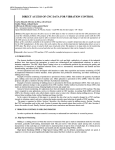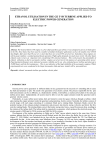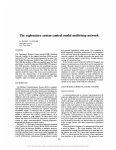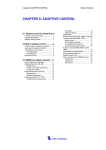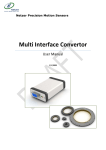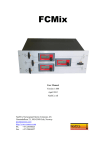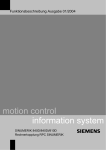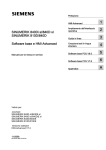Download direct access of cnc data for vibration control
Transcript
Proceedings of COBEM 2009 Copyright © 2009 by ABCM 20th International Congress of Mechanical Engineering November 15-20, 2009, Gramado, RS, Brazil DIRECT ACCESS OF CNC DATA FOR VIBRATION CONTROL Carlos Eduardo Oliveira da Silva, [email protected] Emília Villani, [email protected] Jefferson de Oliveira Gomes, [email protected] ITA - Aeronautics Institute of Technology. Square Marechal Eduardo Gomes, 50, Vila das Acácias – 12228-900. São José dos Campos – SP – Brazil Abstract. This paper discusses the direct access to CNC data in order to control in real time the CNC parameters and avoid the vibration problems. The purpose of the direct data access is to integrate an external system with the CNC controller. This external system must be able to monitor the level of noise and change in real time the parameters of the CNC process in order to avoid excessive vibration. Many of the controllers available in the market for CNC machine have a number of functions that are usually not used by the CNC manufacturer. In this sense, this work explores the use of these functions for implementing direct access to CNC data. The direct access is tested in both ways (read and write). The purpose is to map what are the monitoring parameter that can be directly accessed and what are the control parameters that can be changed in real time. Keywords: direct access, CNC machine, CNC controller, manufacturing process, numeric control. 1. INTRODUCTION In the last years, globalization has pressed industries to reduce product life cycle and time to market, while still increasing product variety. In order to maintain competitiveness, enterprises must search for new technologies and organizational solutions. One technology is HSC - High Speed Cutting. HSC have been successfully applied to many important enterprises of different industrial sectors, such as aeronautics, automotive, mould and die manufacture (Polli, 2005). Among its advantages are reduced production times, improved quality, and product flexibility. One of the main problems that limits the application and the benefits of HSC is vibration. In this context, this paper this paper discusses the direct access to CNC data in order to control in real time the CNC parameters and avoid the vibration problems. The purpose of the direct data access is to integrate an external system with the CNC controller. This external system must be able to monitor the level of noise and change in real time the parameters of the CNC process in order to avoid excessive vibration. Several applications have been developed with the purpose of making data acquisition and remote monitoring of CNC (Computerized Numerical Control) machines. Ferraz (2002) is an example of an application developed with the purpose of production monitoring. It monitors the quantity of produced parts, milling cycle time and speed of machine axis. Similarly, Silva (2008) proposes and applies a method to develop production monitoring software. Other applications aim at monitoring specific parameters of the process in real-time. An example is presented in Del Conte and Schutzer (2007) for the remote monitoring of milling process. This work investigates the best strategy to make data acquisition from a CNC machine. A similar study is presented in Souza (2001), which proposes the strategy of processing data internally to the CNC, in order to obtain higher precision and sample rate. Although many applications about remote monitoring have been developed, the same is not true for remote control of CNC machine. The external control of a CNC machine is required for the addition of extra functionalities to the CNC, such as an automatic vibration control system. Particularly, this paper consider the chatter problem, a kind of machine tool vibration resulted from the generation of chips during machining operations. The chatter control aims to remove or minimize the vibration during the milling process. Polli (2005) and Cabral (2007) studied the problem of chatter control by varying the spindle speed. The results indicated reduced milling time, better surface finishing and longer tool life. In the context, the purpose of this paper is to investigate which kind of data can be exchanged with a CNC machine by a remote computer in real-time in order to automate the chatter control. A basic solution is proposed and tested for remote setting of the spindle speed. This work provides the basis for the development of an automatic chatter control system. The paper is organized as follow. Section 2 describes the problem of chatter control in milling process. Section 3 desribes the CNC tool-machine used in this work. Section 4 presents the research about direct access to CNC data. Secction 5 shows the test results. Finally, Section 6 presents some conclusions and discusses future work. 2. VIBRATION CONTROL IN MILLING PROCESS In order to develop an automatic system form chatter control, the first step is to understand how and where it is generated during the cutting processes. Proceedings of COBEM 2009 Copyright © 2009 by ABCM 20th International Congress of Mechanical Engineering November 15-20, 2009, Gramado, RS, Brazil 2.1. High Speed Machining Milling is a cutting process in which the removal of material from the part is made in intermittent mode by the tool rotational moviment, generally multi-cutting, called mill. The part moves with feed speed across the mill. Each cutting tooth of the mill removes a material portion of the part in the form of small chips. The milling is a widely used industrial process with application in the aeronautical, automotive, moulds and dies manufacturing sectors (Polli, 2005). High Speed Machining (HSM) or High Speed Cutting (HSC) was proposed in 1931 by Carl Salomon. He has assumed that at a certain cutting speed which is about 5 –10 times higher then in conventional machining, the chip tool interface temperature would start to decrease because the machining feed rate would be higher than the thermal conducting speed. Most of the heat generated in the cutting would remain in the chips. 2.2. Machining Vibration Machining of the materials is invariably followed by vibrations between the part and the tool. However, due to the intermittent feature of the milling process this vibration can be self-excited and reach intolerable values. The maximum tolerable vibration level (the maximum vibration amplitude) in a machining process depends on the application. In the roughing operation, the effect of vibration in the tool is mainly what determines the tolerable vibration level. In finishing operation, superficial quality and dimensional precision are the main parameters that determine the maximum vibration level (Altintas, 2000). The appearance of vibration during the milling process is a function of the chip thickness variation that results from the tool or part vibration, or both. These vibrations can have different sources: • External vibrations to machine-tool; • Vibrations caused by machine-tool; • Vibrations caused by interrupted cut; • Vibrations due to lack of part homogeneousness; • Regenerative vibrations (chatter vibrations), which are the scope of this work. Some strategies that can be used to aviod vibration during the milling process are: • Special tools; • Process planning using stability charts; • Cyclic variation of cutting speed; • Vibration detection and control during the milling process. 2.3. Stability of Milling Process In order to verify the stability of a milling process in HSC, stability charts have been frequently used (Schmitz, 2006). Figure 1 shows an example of a stability chart, where y axis is the depth of cut (ap) and the x axis is the tool rotation speed. The blue line delimits the stable region from the unstable one and defines the critical depth of cut. Figure 1 – Stability chart. The border between the stable region and the unstable one depends on the machining rotation speed and depth of cut. The stability chart can be obtained from dynamic modeling and analysis, using finite element methods, or can be obtained from the processing of experimental data (Bayly et al, 2002). In these cases, the machine dynamic behavior can be characterized by the data obtained from an impact hammer test and/or modal analysis using a set of Proceedings of COBEM 2009 Copyright © 2009 by ABCM 20th International Congress of Mechanical Engineering November 15-20, 2009, Gramado, RS, Brazil accelerometers. The frequency response function (FRF) is determined from the vibration amplitude measured in tool end. The multiple modes for higher frequencies can be estimated from the experiment results. Another approach is to perform the milling operation varying the depth of cut for a set of fixed rotation speed. The stability chart allows the user to select the appropriate tool rotation speed avoiding unstabilities. In roughing operations, a high radial depth of cut is used. In these cases, the user must select a tool rotation value in the peak regions of the stability chart (which allows a high depth of cut without instability). In finishing operations, a low radial depth of cut is used. The user must select a tool rotation value in the valleys of stability chart. The cutting parameters of milling process that influence the vibration stability are: • Axial cutting depth; • Radial cutting depth; • Cutting speed; • Tool feed; • Number of tool teeth. 2.4. Vibration Control In order to control the vibration during the milling process, the user had to perform a set of tests, collect and process the corresponding data. The first pass is the impact hammer test, which provides the FRF (Frequency Response Function). After obtain the FRF and considering the number of teeth in the tool, the user must start an exhaustive testing cycle to obtain the maximum stable depth of cut for each tool rotation value. For each tool rotation speed the depth of cut is progressively increased. The maximum stable depth is selected according to the sound pressure measured by a microphone installed in the CNC machine and processed by a data acquisition system. After obtaining the stability chart, the best spindle speed is selected and set in the CNC machine for that specific tool. This vibration avoidance process is illustrated in Fig. 2. Impact test Genetate FRF Select spindle speed Search ap limit Find best spindle speed Augment spindle speed Figure 2. Vibration avoidance process. In this context, this work investigates one of the problems related to the automation of this vibration avoidance process, which is the automatic replacement of the tool rotation speed in the CNC machine. 3. CNC TOOL-MACHINE The CNC tool-machine of this work is manufactured by Hermle and model C600U, and is located in the CCM Laboratory (Center of Competence of Manufacturing) of ITA (Aeronautics Institute of Technology). This machine works with HSM (High Speed Machining) technology. The Hermle machine has five movement axes (X, Y, Z, A e C). The machine and movement axes are showed in Fig. 3. In order to control the axes motion, the tool-machine uses a CNC controller made by Siemens, model Sinumerik 840D. This system has a high capacity of information processing and a mixed architecture, which integrates a CNC (Computerized Numerical Controller) and PLC (Programmable Logic Controller) from the Simatic S7-300 family. The Hermle machine uses a serial communication protocol, the MPI (Multiple Protocol Interface, a simple version of Profibus) to connect in a single network the processing components, such as the HMI (Human-Machine Interface), the PLC (Programmable Logic Controller), control panel and others (Siemens, 2006). Proceedings of COBEM 2009 Copyright © 2009 by ABCM 20th International Congress of Mechanical Engineering November 15-20, 2009, Gramado, RS, Brazil Figure 3. CNC tool-machine Hermle and movement axes. 4. RESEARCH ABOUT DIRECT ACCESS TO CNC DATA The focus of this paper is vibration control, and it must guide all over the research of direct access of CNC data. As showed in Section 2, one way to control the vibration in a CNC machine is to set the appropriate tool rotation speed, which guarantees the process stability. In order to automate this step, it is necessary to input a command to CNC machine from external device and select the spindle speed. Silva (2008) presented a solution to make data acquition from CNC machine using DDE variables. This aplication used the same CNC controller of Hermle machine. The same approach is followed for providing control data to the CNC variables. Figure 4 illustrates the system architecture that is used in this case. Figure 4 – System architecture Proceedings of COBEM 2009 Copyright © 2009 by ABCM 20th International Congress of Mechanical Engineering November 15-20, 2009, Gramado, RS, Brazil The system architecture is composed by: Hermle CNC machine, Siemens PCI board CP 5611 and a PC (Personal Computer). In this case, the acquisition system will be used as interface system to connect both devices in bi-directional communication. The programming tool uses the NC (Numerical Control) variables as DDE (Dynamic Data Exchage) variables. This is possible due to the Siemens converter provided together with the CP 5611 board. The converter, called NCDDE Server, converts NC variables in DDE variables, and vice-versa. Figure 5 illustrates the data conversion from the CNC machine to programming tool. Machine PC CP 5611 Machine data MPI net NC variables NCDDE converter DDE variables Programming software Figure 5 – Data exchanging between CNC machine and programming software. When CNC controller receives a command to start the spindle, internally the controller creates a desired spindle speed variable and an actual spindle speed variable. The tests performed showed that the desired spindle speed variable cannot be written from an external device. This is a read-only variable of the CNC controller (Siemens, 1997). DDE variables: “/Channel/Spindle/cmdSpeed[1]”, only read; “/Channel/Spindle/actSpeed[1]”, only read. According Silva (2008), the PLC variables and R parameters from Siemens CNC controller can be changed from outside of controller. The following solution is then tested to change the desired spindle speed variable. The main idea is to use a R parameter to select the spindle speed before the starting of the CNC program. This is done by inserting one programming line in the CNC program. In the program line that turns on the spindle, instead of indicating the desired spindle speed, the program must point to a R parameter of the CNC, as following: “M3 S5000”, start the spindle speed with 5000 rpm; “M3 S=R10”, start the spindle speed with rpm recorded in R10 parameter. The R10 parameter must be set before the starting of the CNC program. If this is not the case, the CNC controller will use the last recorded value. DDE variables: “/Channel/Parameter/R[10]”, R10 parameter; “/Plc/Input/Bit[2.1]”, set start CNC program; “/Plc/Input/Bit[3.7]” set stop CNC program. Using the DDE variable, a remote automatic system can select the correct spindle speed before the starting of a CNC program, starts and stops CNC program. 5. RESULTS The proposed solution was tested using an application developed in Visual Basic 6, which provides a set of commands to handle DDE variables. This application inserts a command to select the spindle speed, a function to monitor the spindle speed, a command to start CNC program and a command to stop the CNC program. Before running the developed application, the NCDDE server must be initialized. The application is illustrated in Figure 6 and is called Spindle Control Software. The example shows the case of selecting a spindle speed of 1000 rpm and starting the CNC program. As a result, the machine spindle received the command, and set the rotation speed. The application shows that the proposed solution can be used to control the spindle speed of a Siemens CNC machine from a remote device. Proceedings of COBEM 2009 Copyright © 2009 by ABCM 20th International Congress of Mechanical Engineering November 15-20, 2009, Gramado, RS, Brazil 6. CONCLUSIONS This paper presents and discusses a solution to set the CNC read-only variable from an external device. The purpose is to contribute for the development of an automatic vibration control system. The solution is based on the pointing of the CNC variable to a R parameter. By this way it is possible to develop an application that runs in an external device and sets the appropriate tool rotation speed. Figure 6 – Spindle Control 7. ACKNOWLEDGEMENTS This research is supported by governmental agencies CAPES, FAPESP, CNPq and FINEP. 8. REFERENCES Altintas, Y. Manufacturing Automation. United States of America: 1. Ed. Cambridge University Press, 288 pg, 2000. Bayly, P.; Schmitz, T.; Peters, D.; Mann, B.; Stépán, G.; Insperger, T. Efects of Radial Immersion and Cuttong Direction on Chatter Instability in End-Milling. In Proceedings of ASME International Mechanical Engineering Congress and Exposition. New Orleans, LA, 2002. Cabral, G. F. Determination of Machining Requirements for Alumium Components Manufacturing. Dissertation (Master in Aeronautics and Mechanical Engineering), Aeronautics Institute of Technology, São José dos Campos, 2007. Del Conte, E. G.; Schutzer, K. Data Acquisition Strategy for Open CNC Monitoring in HSM Process. In: International Congrees of Mechanical Engineering (COBEM), 19., 2007. Brasília, DF. Proceedings… Rio de Janeiro: ABCM, 2007. Ferraz Jr, F. Development of Monitoring and Supervisory System for Turning Process. Dissertation (Master in Mechanical Engineering), Engineering School of São Carlos of the University of São Paulo, São Paulo, 2002. Polli, M. P. Analisys of Dynamic Stability of Milling Process High Speed Cutting. Thesis (Doctor in Mechanical Engineering), University of Santa Catarina, Florianópolis, 2005. Schmitz, T. What is chatter? <http://highspeedmachining.mae.ufl.edu/htmlsite/faq.html>, 2006. SIEMENS. Sinumerik 840D / 810D / FN-NC OEM package MMC User’s Manual. 12.ed. 1997. SIEMENS. Automation Systems for Machine Tools Catalog NC 60. 2006 Silva, C. E. O. da. Remote Monitoring System of Manufacturing Process. Dissertation (Master in Aeronautics and Mechanical Engineering), Aeronautics Institute of Technology, São José dos Campos, 2008. Souza, A. F. Interpolation Analisys of Tool Path in HSC (High Speed Cutting) Machining of Complex Surfaces. Dissertation (Master in Production Engineering), University Metodista de Piracicaba, São Paulo, 2001. Proceedings of COBEM 2009 Copyright © 2009 by ABCM 20th International Congress of Mechanical Engineering November 15-20, 2009, Gramado, RS, Brazil 9. RESPONSIBILITY NOTICE The authors are the only responsible for the printed material included in this paper.







